Computer, Crime, and Security: Types, Attacks, and Countermeasures
VerifiedAdded on 2022/09/08
|11
|2631
|18
Report
AI Summary
This report comprehensively examines computer crime and security, delving into the various aspects of cyber threats and protective measures. The report begins with an introduction to the importance of computer security in the face of increasing cybercrimes, followed by research questions and a literature review. It then explores different types of cyber attacks, including military, business, financial, terrorism, and grudge attacks. The report also categorizes offenders in cybercrimes, such as crackers, vandals, and criminals, and discusses different types of cybercrimes and their control measures, including breaches of physical and personal security, and data security. Furthermore, it covers countermeasures to physical security breaches, personal security breaches, and data security breaches, including investigative methods like introductory assessment. The report provides a detailed analysis of each type of attack and the measures to be taken to prevent them, making it a useful resource for anyone interested in understanding and combating cybercrime.
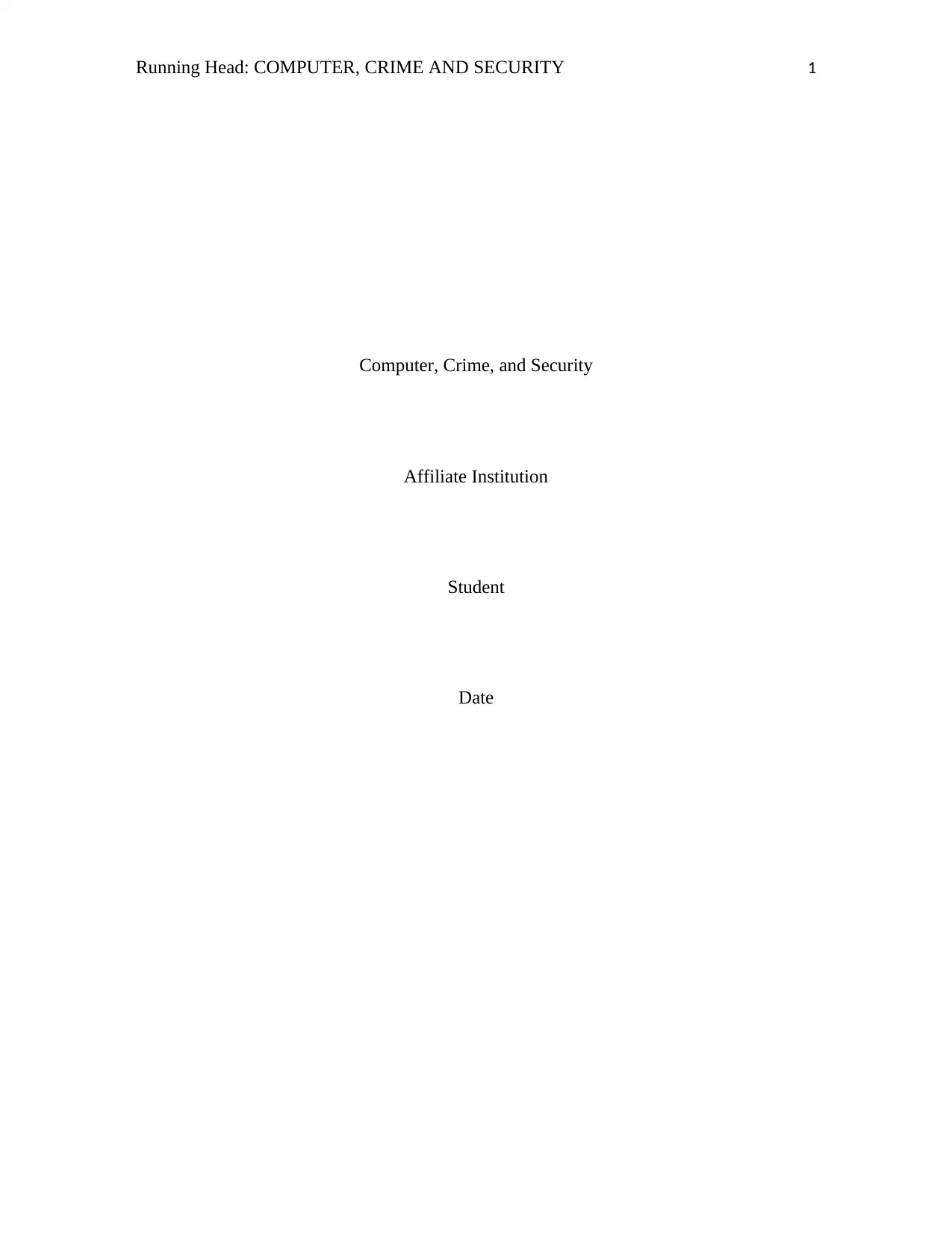
Running Head: COMPUTER, CRIME AND SECURITY 1
Computer, Crime, and Security
Affiliate Institution
Student
Date
Computer, Crime, and Security
Affiliate Institution
Student
Date
Paraphrase This Document
Need a fresh take? Get an instant paraphrase of this document with our AI Paraphraser
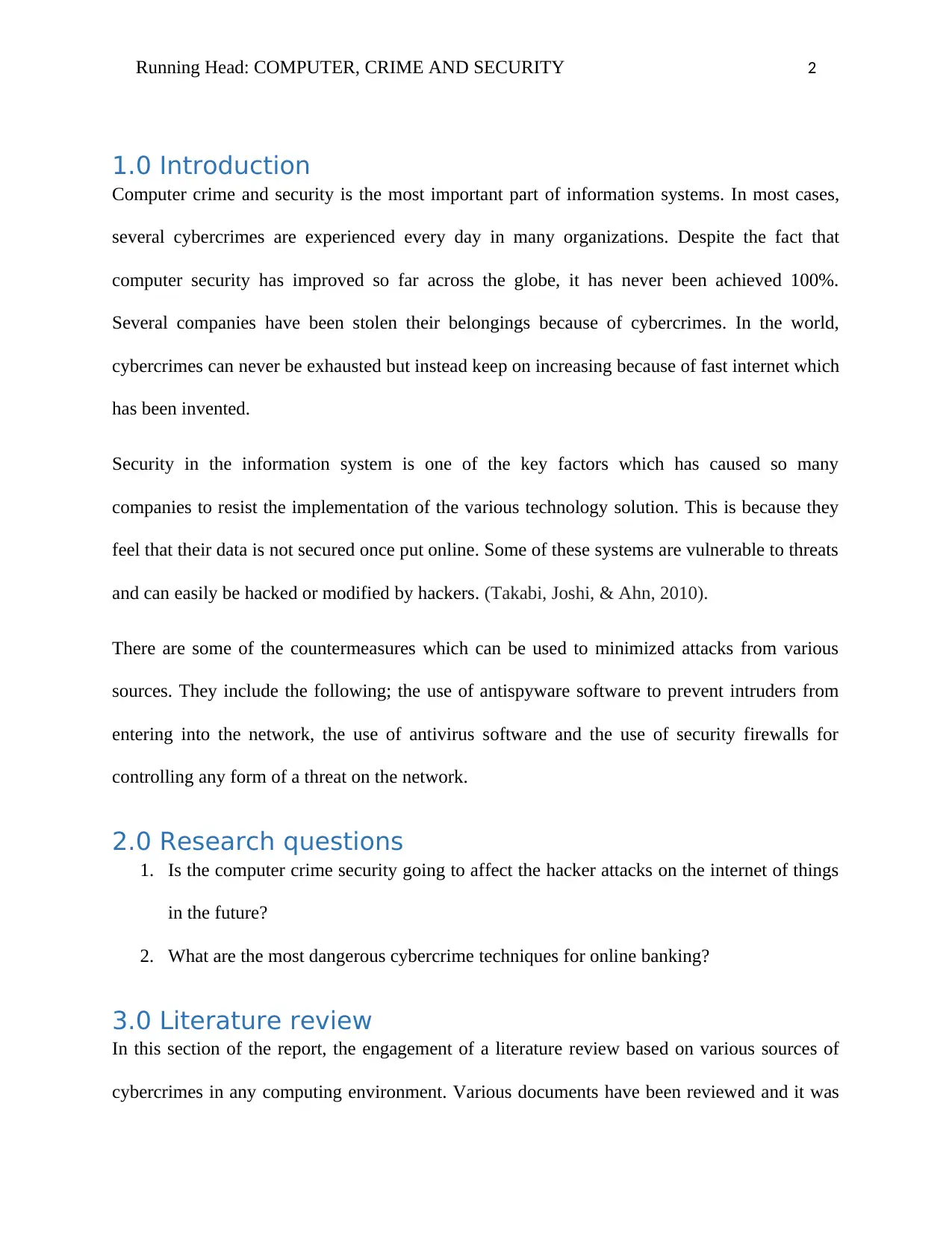
Running Head: COMPUTER, CRIME AND SECURITY 2
1.0 Introduction
Computer crime and security is the most important part of information systems. In most cases,
several cybercrimes are experienced every day in many organizations. Despite the fact that
computer security has improved so far across the globe, it has never been achieved 100%.
Several companies have been stolen their belongings because of cybercrimes. In the world,
cybercrimes can never be exhausted but instead keep on increasing because of fast internet which
has been invented.
Security in the information system is one of the key factors which has caused so many
companies to resist the implementation of the various technology solution. This is because they
feel that their data is not secured once put online. Some of these systems are vulnerable to threats
and can easily be hacked or modified by hackers. (Takabi, Joshi, & Ahn, 2010).
There are some of the countermeasures which can be used to minimized attacks from various
sources. They include the following; the use of antispyware software to prevent intruders from
entering into the network, the use of antivirus software and the use of security firewalls for
controlling any form of a threat on the network.
2.0 Research questions
1. Is the computer crime security going to affect the hacker attacks on the internet of things
in the future?
2. What are the most dangerous cybercrime techniques for online banking?
3.0 Literature review
In this section of the report, the engagement of a literature review based on various sources of
cybercrimes in any computing environment. Various documents have been reviewed and it was
1.0 Introduction
Computer crime and security is the most important part of information systems. In most cases,
several cybercrimes are experienced every day in many organizations. Despite the fact that
computer security has improved so far across the globe, it has never been achieved 100%.
Several companies have been stolen their belongings because of cybercrimes. In the world,
cybercrimes can never be exhausted but instead keep on increasing because of fast internet which
has been invented.
Security in the information system is one of the key factors which has caused so many
companies to resist the implementation of the various technology solution. This is because they
feel that their data is not secured once put online. Some of these systems are vulnerable to threats
and can easily be hacked or modified by hackers. (Takabi, Joshi, & Ahn, 2010).
There are some of the countermeasures which can be used to minimized attacks from various
sources. They include the following; the use of antispyware software to prevent intruders from
entering into the network, the use of antivirus software and the use of security firewalls for
controlling any form of a threat on the network.
2.0 Research questions
1. Is the computer crime security going to affect the hacker attacks on the internet of things
in the future?
2. What are the most dangerous cybercrime techniques for online banking?
3.0 Literature review
In this section of the report, the engagement of a literature review based on various sources of
cybercrimes in any computing environment. Various documents have been reviewed and it was
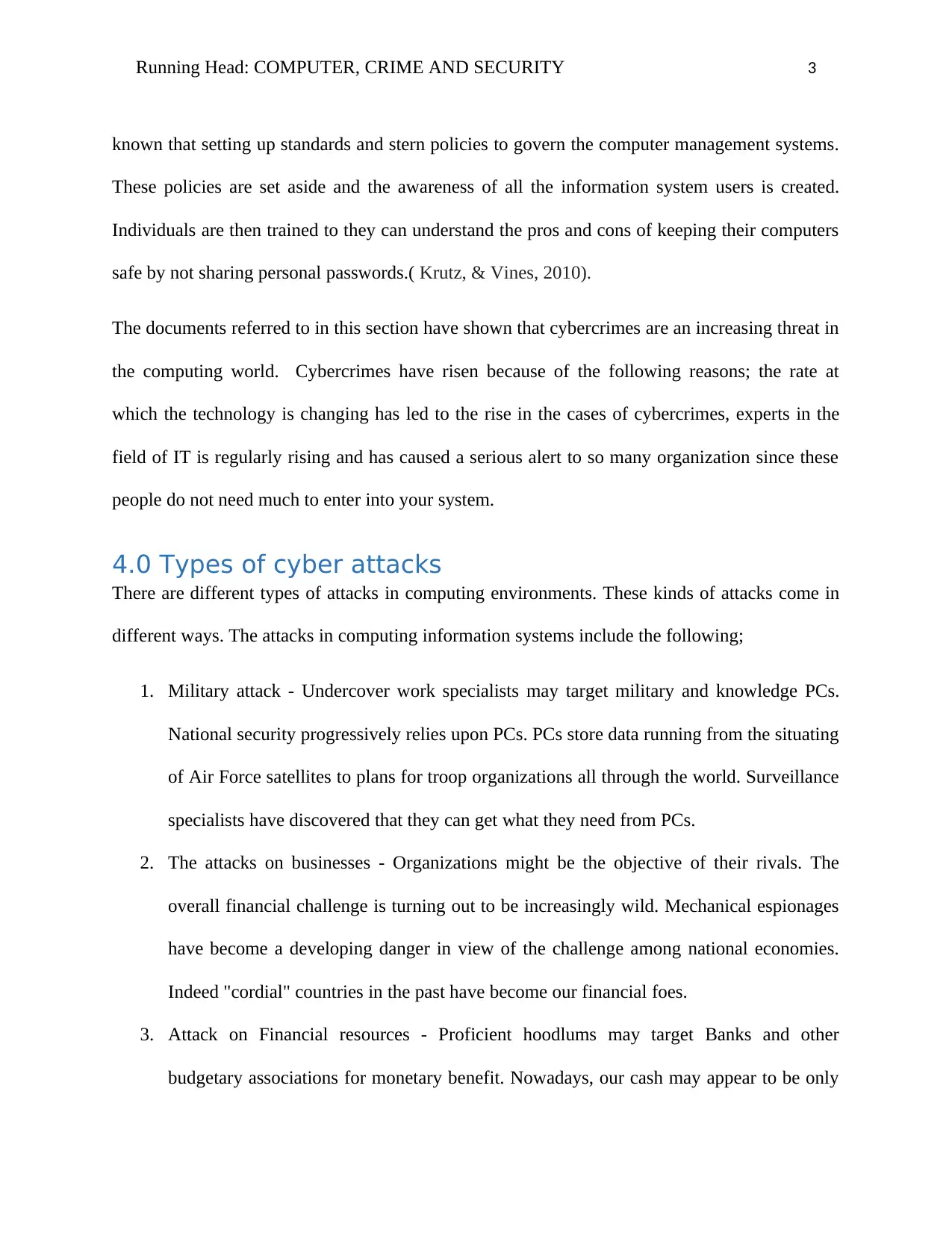
Running Head: COMPUTER, CRIME AND SECURITY 3
known that setting up standards and stern policies to govern the computer management systems.
These policies are set aside and the awareness of all the information system users is created.
Individuals are then trained to they can understand the pros and cons of keeping their computers
safe by not sharing personal passwords.( Krutz, & Vines, 2010).
The documents referred to in this section have shown that cybercrimes are an increasing threat in
the computing world. Cybercrimes have risen because of the following reasons; the rate at
which the technology is changing has led to the rise in the cases of cybercrimes, experts in the
field of IT is regularly rising and has caused a serious alert to so many organization since these
people do not need much to enter into your system.
4.0 Types of cyber attacks
There are different types of attacks in computing environments. These kinds of attacks come in
different ways. The attacks in computing information systems include the following;
1. Military attack - Undercover work specialists may target military and knowledge PCs.
National security progressively relies upon PCs. PCs store data running from the situating
of Air Force satellites to plans for troop organizations all through the world. Surveillance
specialists have discovered that they can get what they need from PCs.
2. The attacks on businesses - Organizations might be the objective of their rivals. The
overall financial challenge is turning out to be increasingly wild. Mechanical espionages
have become a developing danger in view of the challenge among national economies.
Indeed "cordial" countries in the past have become our financial foes.
3. Attack on Financial resources - Proficient hoodlums may target Banks and other
budgetary associations for monetary benefit. Nowadays, our cash may appear to be only
known that setting up standards and stern policies to govern the computer management systems.
These policies are set aside and the awareness of all the information system users is created.
Individuals are then trained to they can understand the pros and cons of keeping their computers
safe by not sharing personal passwords.( Krutz, & Vines, 2010).
The documents referred to in this section have shown that cybercrimes are an increasing threat in
the computing world. Cybercrimes have risen because of the following reasons; the rate at
which the technology is changing has led to the rise in the cases of cybercrimes, experts in the
field of IT is regularly rising and has caused a serious alert to so many organization since these
people do not need much to enter into your system.
4.0 Types of cyber attacks
There are different types of attacks in computing environments. These kinds of attacks come in
different ways. The attacks in computing information systems include the following;
1. Military attack - Undercover work specialists may target military and knowledge PCs.
National security progressively relies upon PCs. PCs store data running from the situating
of Air Force satellites to plans for troop organizations all through the world. Surveillance
specialists have discovered that they can get what they need from PCs.
2. The attacks on businesses - Organizations might be the objective of their rivals. The
overall financial challenge is turning out to be increasingly wild. Mechanical espionages
have become a developing danger in view of the challenge among national economies.
Indeed "cordial" countries in the past have become our financial foes.
3. Attack on Financial resources - Proficient hoodlums may target Banks and other
budgetary associations for monetary benefit. Nowadays, our cash may appear to be only
⊘ This is a preview!⊘
Do you want full access?
Subscribe today to unlock all pages.

Trusted by 1+ million students worldwide
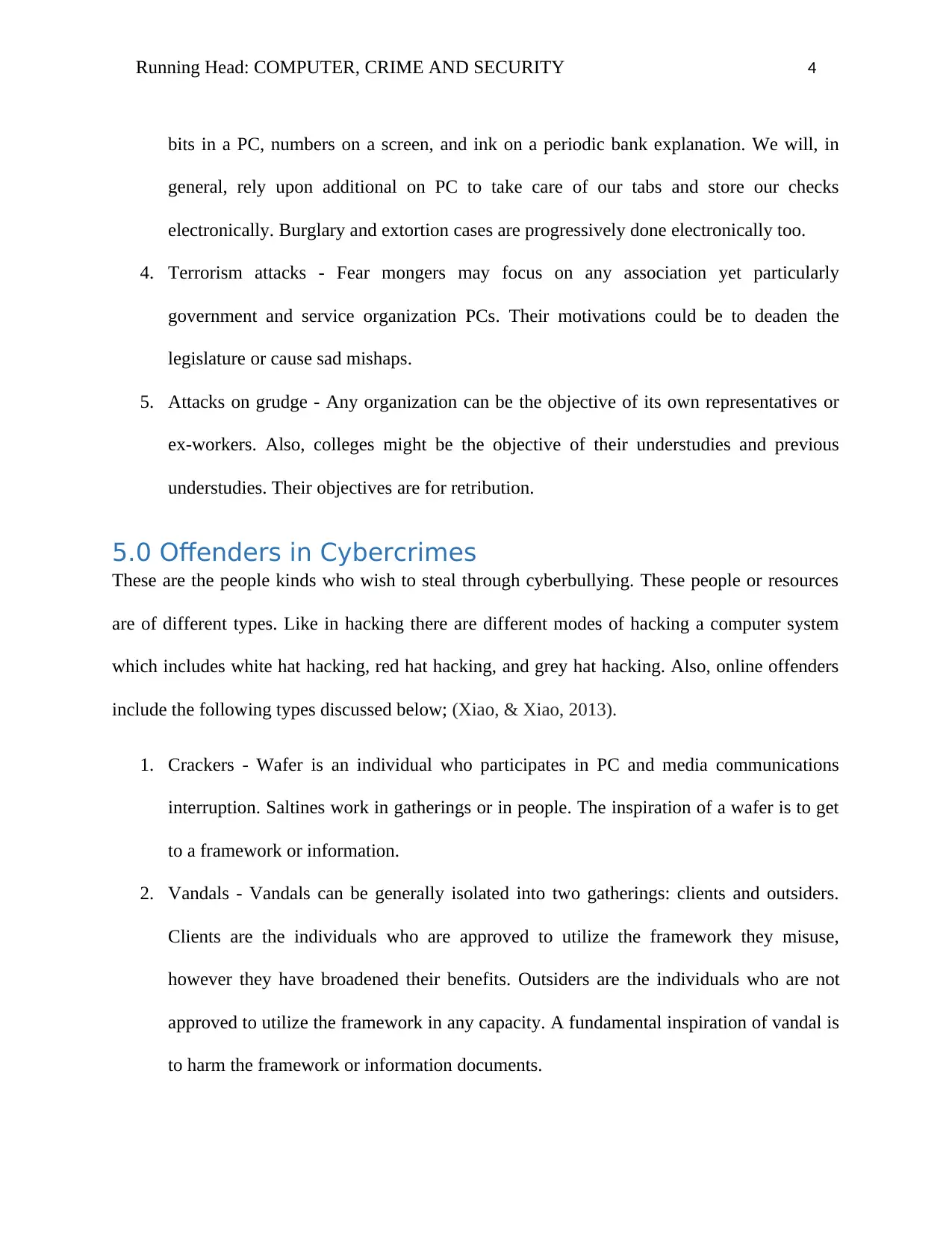
Running Head: COMPUTER, CRIME AND SECURITY 4
bits in a PC, numbers on a screen, and ink on a periodic bank explanation. We will, in
general, rely upon additional on PC to take care of our tabs and store our checks
electronically. Burglary and extortion cases are progressively done electronically too.
4. Terrorism attacks - Fear mongers may focus on any association yet particularly
government and service organization PCs. Their motivations could be to deaden the
legislature or cause sad mishaps.
5. Attacks on grudge - Any organization can be the objective of its own representatives or
ex-workers. Also, colleges might be the objective of their understudies and previous
understudies. Their objectives are for retribution.
5.0 Offenders in Cybercrimes
These are the people kinds who wish to steal through cyberbullying. These people or resources
are of different types. Like in hacking there are different modes of hacking a computer system
which includes white hat hacking, red hat hacking, and grey hat hacking. Also, online offenders
include the following types discussed below; (Xiao, & Xiao, 2013).
1. Crackers - Wafer is an individual who participates in PC and media communications
interruption. Saltines work in gatherings or in people. The inspiration of a wafer is to get
to a framework or information.
2. Vandals - Vandals can be generally isolated into two gatherings: clients and outsiders.
Clients are the individuals who are approved to utilize the framework they misuse,
however they have broadened their benefits. Outsiders are the individuals who are not
approved to utilize the framework in any capacity. A fundamental inspiration of vandal is
to harm the framework or information documents.
bits in a PC, numbers on a screen, and ink on a periodic bank explanation. We will, in
general, rely upon additional on PC to take care of our tabs and store our checks
electronically. Burglary and extortion cases are progressively done electronically too.
4. Terrorism attacks - Fear mongers may focus on any association yet particularly
government and service organization PCs. Their motivations could be to deaden the
legislature or cause sad mishaps.
5. Attacks on grudge - Any organization can be the objective of its own representatives or
ex-workers. Also, colleges might be the objective of their understudies and previous
understudies. Their objectives are for retribution.
5.0 Offenders in Cybercrimes
These are the people kinds who wish to steal through cyberbullying. These people or resources
are of different types. Like in hacking there are different modes of hacking a computer system
which includes white hat hacking, red hat hacking, and grey hat hacking. Also, online offenders
include the following types discussed below; (Xiao, & Xiao, 2013).
1. Crackers - Wafer is an individual who participates in PC and media communications
interruption. Saltines work in gatherings or in people. The inspiration of a wafer is to get
to a framework or information.
2. Vandals - Vandals can be generally isolated into two gatherings: clients and outsiders.
Clients are the individuals who are approved to utilize the framework they misuse,
however they have broadened their benefits. Outsiders are the individuals who are not
approved to utilize the framework in any capacity. A fundamental inspiration of vandal is
to harm the framework or information documents.
Paraphrase This Document
Need a fresh take? Get an instant paraphrase of this document with our AI Paraphraser
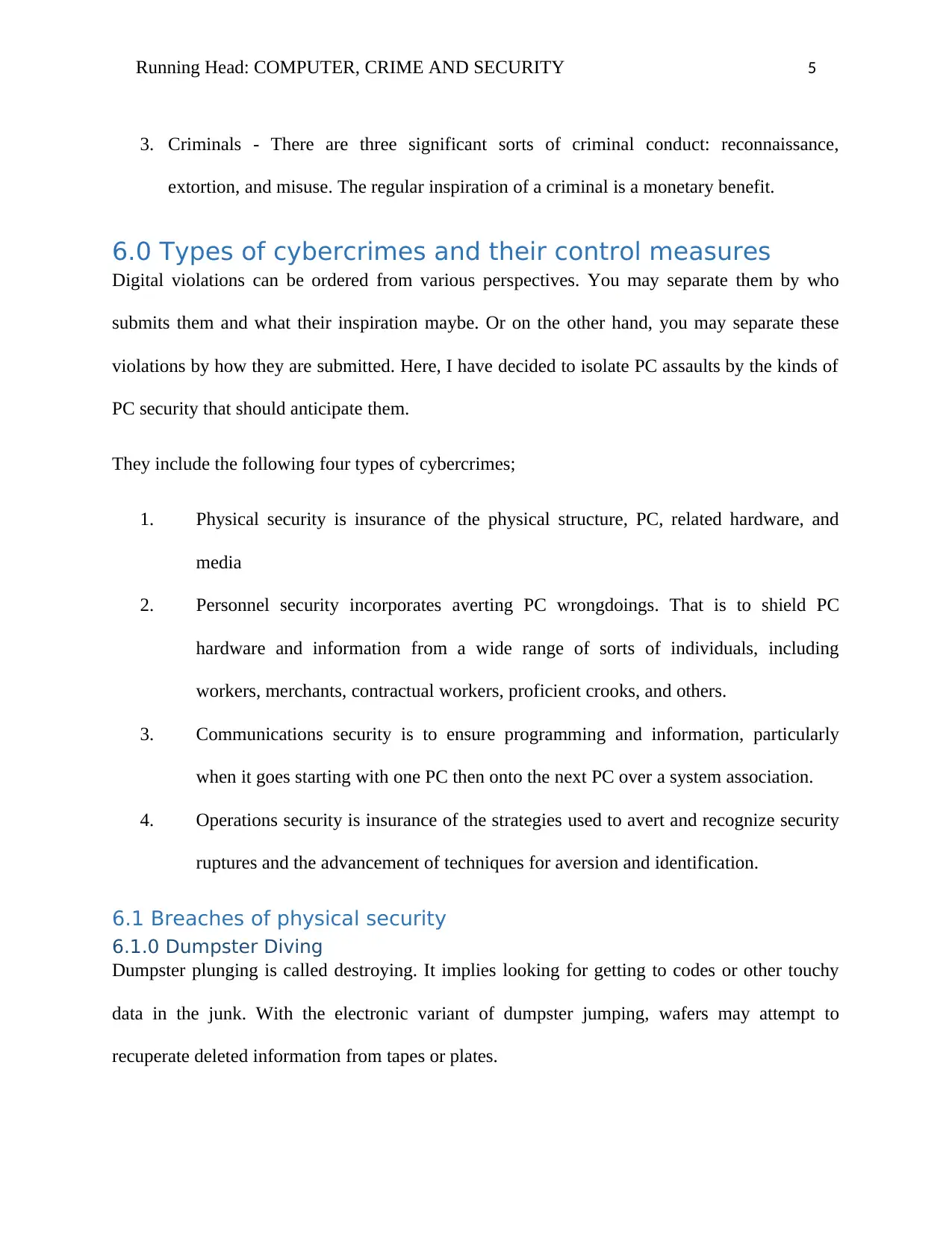
Running Head: COMPUTER, CRIME AND SECURITY 5
3. Criminals - There are three significant sorts of criminal conduct: reconnaissance,
extortion, and misuse. The regular inspiration of a criminal is a monetary benefit.
6.0 Types of cybercrimes and their control measures
Digital violations can be ordered from various perspectives. You may separate them by who
submits them and what their inspiration maybe. Or on the other hand, you may separate these
violations by how they are submitted. Here, I have decided to isolate PC assaults by the kinds of
PC security that should anticipate them.
They include the following four types of cybercrimes;
1. Physical security is insurance of the physical structure, PC, related hardware, and
media
2. Personnel security incorporates averting PC wrongdoings. That is to shield PC
hardware and information from a wide range of sorts of individuals, including
workers, merchants, contractual workers, proficient crooks, and others.
3. Communications security is to ensure programming and information, particularly
when it goes starting with one PC then onto the next PC over a system association.
4. Operations security is insurance of the strategies used to avert and recognize security
ruptures and the advancement of techniques for aversion and identification.
6.1 Breaches of physical security
6.1.0 Dumpster Diving
Dumpster plunging is called destroying. It implies looking for getting to codes or other touchy
data in the junk. With the electronic variant of dumpster jumping, wafers may attempt to
recuperate deleted information from tapes or plates.
3. Criminals - There are three significant sorts of criminal conduct: reconnaissance,
extortion, and misuse. The regular inspiration of a criminal is a monetary benefit.
6.0 Types of cybercrimes and their control measures
Digital violations can be ordered from various perspectives. You may separate them by who
submits them and what their inspiration maybe. Or on the other hand, you may separate these
violations by how they are submitted. Here, I have decided to isolate PC assaults by the kinds of
PC security that should anticipate them.
They include the following four types of cybercrimes;
1. Physical security is insurance of the physical structure, PC, related hardware, and
media
2. Personnel security incorporates averting PC wrongdoings. That is to shield PC
hardware and information from a wide range of sorts of individuals, including
workers, merchants, contractual workers, proficient crooks, and others.
3. Communications security is to ensure programming and information, particularly
when it goes starting with one PC then onto the next PC over a system association.
4. Operations security is insurance of the strategies used to avert and recognize security
ruptures and the advancement of techniques for aversion and identification.
6.1 Breaches of physical security
6.1.0 Dumpster Diving
Dumpster plunging is called destroying. It implies looking for getting to codes or other touchy
data in the junk. With the electronic variant of dumpster jumping, wafers may attempt to
recuperate deleted information from tapes or plates.
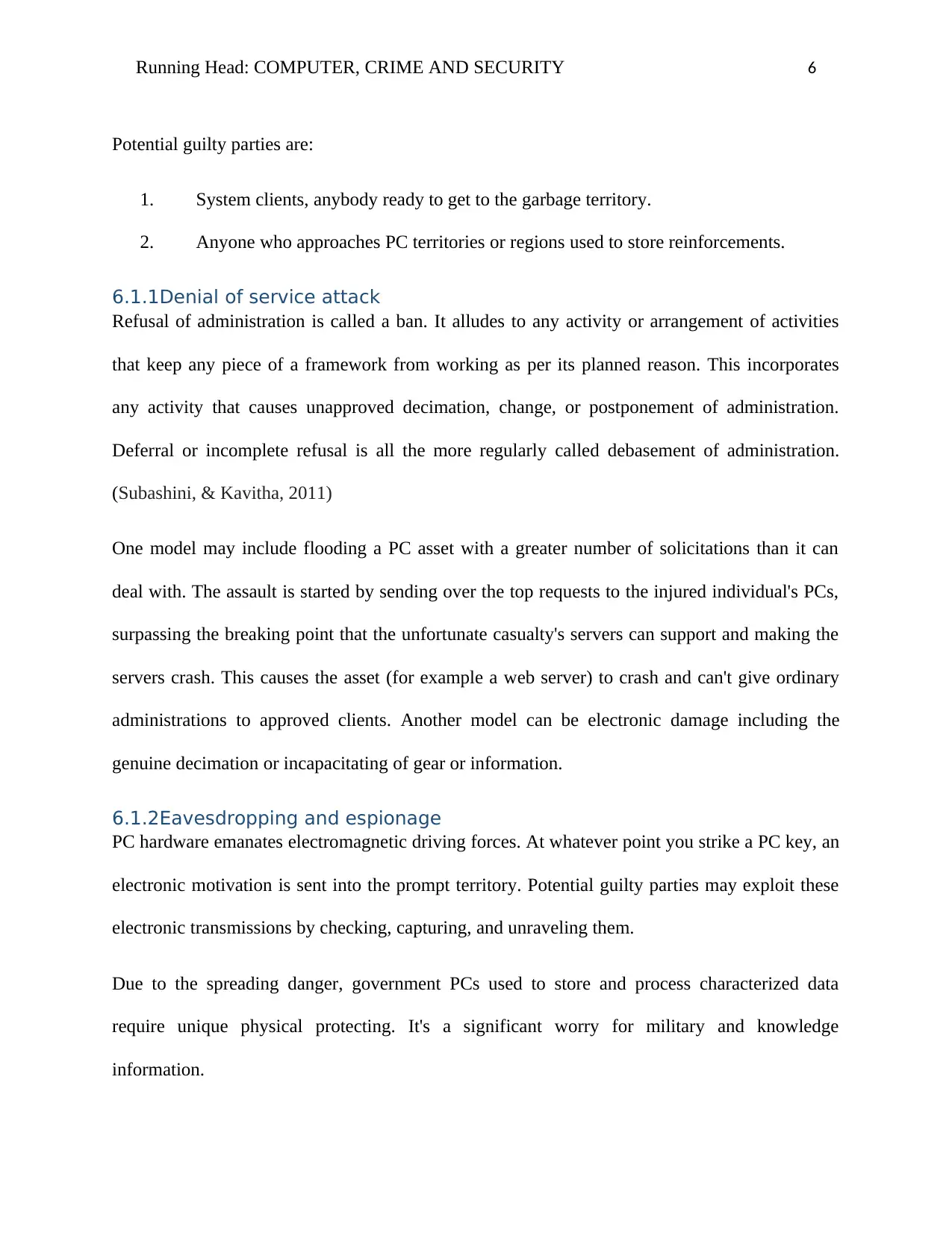
Running Head: COMPUTER, CRIME AND SECURITY 6
Potential guilty parties are:
1. System clients, anybody ready to get to the garbage territory.
2. Anyone who approaches PC territories or regions used to store reinforcements.
6.1.1Denial of service attack
Refusal of administration is called a ban. It alludes to any activity or arrangement of activities
that keep any piece of a framework from working as per its planned reason. This incorporates
any activity that causes unapproved decimation, change, or postponement of administration.
Deferral or incomplete refusal is all the more regularly called debasement of administration.
(Subashini, & Kavitha, 2011)
One model may include flooding a PC asset with a greater number of solicitations than it can
deal with. The assault is started by sending over the top requests to the injured individual's PCs,
surpassing the breaking point that the unfortunate casualty's servers can support and making the
servers crash. This causes the asset (for example a web server) to crash and can't give ordinary
administrations to approved clients. Another model can be electronic damage including the
genuine decimation or incapacitating of gear or information.
6.1.2Eavesdropping and espionage
PC hardware emanates electromagnetic driving forces. At whatever point you strike a PC key, an
electronic motivation is sent into the prompt territory. Potential guilty parties may exploit these
electronic transmissions by checking, capturing, and unraveling them.
Due to the spreading danger, government PCs used to store and process characterized data
require unique physical protecting. It's a significant worry for military and knowledge
information.
Potential guilty parties are:
1. System clients, anybody ready to get to the garbage territory.
2. Anyone who approaches PC territories or regions used to store reinforcements.
6.1.1Denial of service attack
Refusal of administration is called a ban. It alludes to any activity or arrangement of activities
that keep any piece of a framework from working as per its planned reason. This incorporates
any activity that causes unapproved decimation, change, or postponement of administration.
Deferral or incomplete refusal is all the more regularly called debasement of administration.
(Subashini, & Kavitha, 2011)
One model may include flooding a PC asset with a greater number of solicitations than it can
deal with. The assault is started by sending over the top requests to the injured individual's PCs,
surpassing the breaking point that the unfortunate casualty's servers can support and making the
servers crash. This causes the asset (for example a web server) to crash and can't give ordinary
administrations to approved clients. Another model can be electronic damage including the
genuine decimation or incapacitating of gear or information.
6.1.2Eavesdropping and espionage
PC hardware emanates electromagnetic driving forces. At whatever point you strike a PC key, an
electronic motivation is sent into the prompt territory. Potential guilty parties may exploit these
electronic transmissions by checking, capturing, and unraveling them.
Due to the spreading danger, government PCs used to store and process characterized data
require unique physical protecting. It's a significant worry for military and knowledge
information.
⊘ This is a preview!⊘
Do you want full access?
Subscribe today to unlock all pages.

Trusted by 1+ million students worldwide
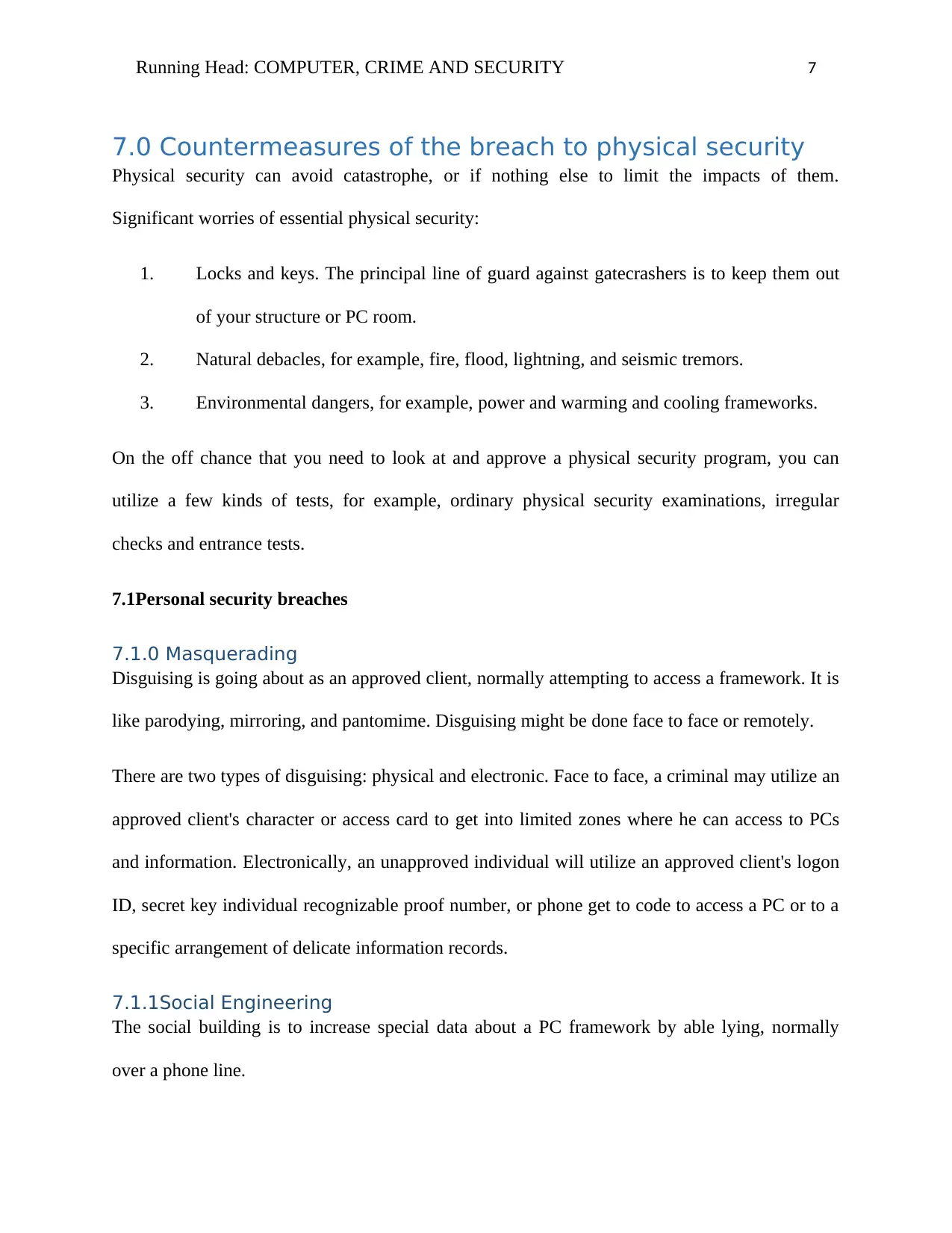
Running Head: COMPUTER, CRIME AND SECURITY 7
7.0 Countermeasures of the breach to physical security
Physical security can avoid catastrophe, or if nothing else to limit the impacts of them.
Significant worries of essential physical security:
1. Locks and keys. The principal line of guard against gatecrashers is to keep them out
of your structure or PC room.
2. Natural debacles, for example, fire, flood, lightning, and seismic tremors.
3. Environmental dangers, for example, power and warming and cooling frameworks.
On the off chance that you need to look at and approve a physical security program, you can
utilize a few kinds of tests, for example, ordinary physical security examinations, irregular
checks and entrance tests.
7.1Personal security breaches
7.1.0 Masquerading
Disguising is going about as an approved client, normally attempting to access a framework. It is
like parodying, mirroring, and pantomime. Disguising might be done face to face or remotely.
There are two types of disguising: physical and electronic. Face to face, a criminal may utilize an
approved client's character or access card to get into limited zones where he can access to PCs
and information. Electronically, an unapproved individual will utilize an approved client's logon
ID, secret key individual recognizable proof number, or phone get to code to access a PC or to a
specific arrangement of delicate information records.
7.1.1Social Engineering
The social building is to increase special data about a PC framework by able lying, normally
over a phone line.
7.0 Countermeasures of the breach to physical security
Physical security can avoid catastrophe, or if nothing else to limit the impacts of them.
Significant worries of essential physical security:
1. Locks and keys. The principal line of guard against gatecrashers is to keep them out
of your structure or PC room.
2. Natural debacles, for example, fire, flood, lightning, and seismic tremors.
3. Environmental dangers, for example, power and warming and cooling frameworks.
On the off chance that you need to look at and approve a physical security program, you can
utilize a few kinds of tests, for example, ordinary physical security examinations, irregular
checks and entrance tests.
7.1Personal security breaches
7.1.0 Masquerading
Disguising is going about as an approved client, normally attempting to access a framework. It is
like parodying, mirroring, and pantomime. Disguising might be done face to face or remotely.
There are two types of disguising: physical and electronic. Face to face, a criminal may utilize an
approved client's character or access card to get into limited zones where he can access to PCs
and information. Electronically, an unapproved individual will utilize an approved client's logon
ID, secret key individual recognizable proof number, or phone get to code to access a PC or to a
specific arrangement of delicate information records.
7.1.1Social Engineering
The social building is to increase special data about a PC framework by able lying, normally
over a phone line.
Paraphrase This Document
Need a fresh take? Get an instant paraphrase of this document with our AI Paraphraser
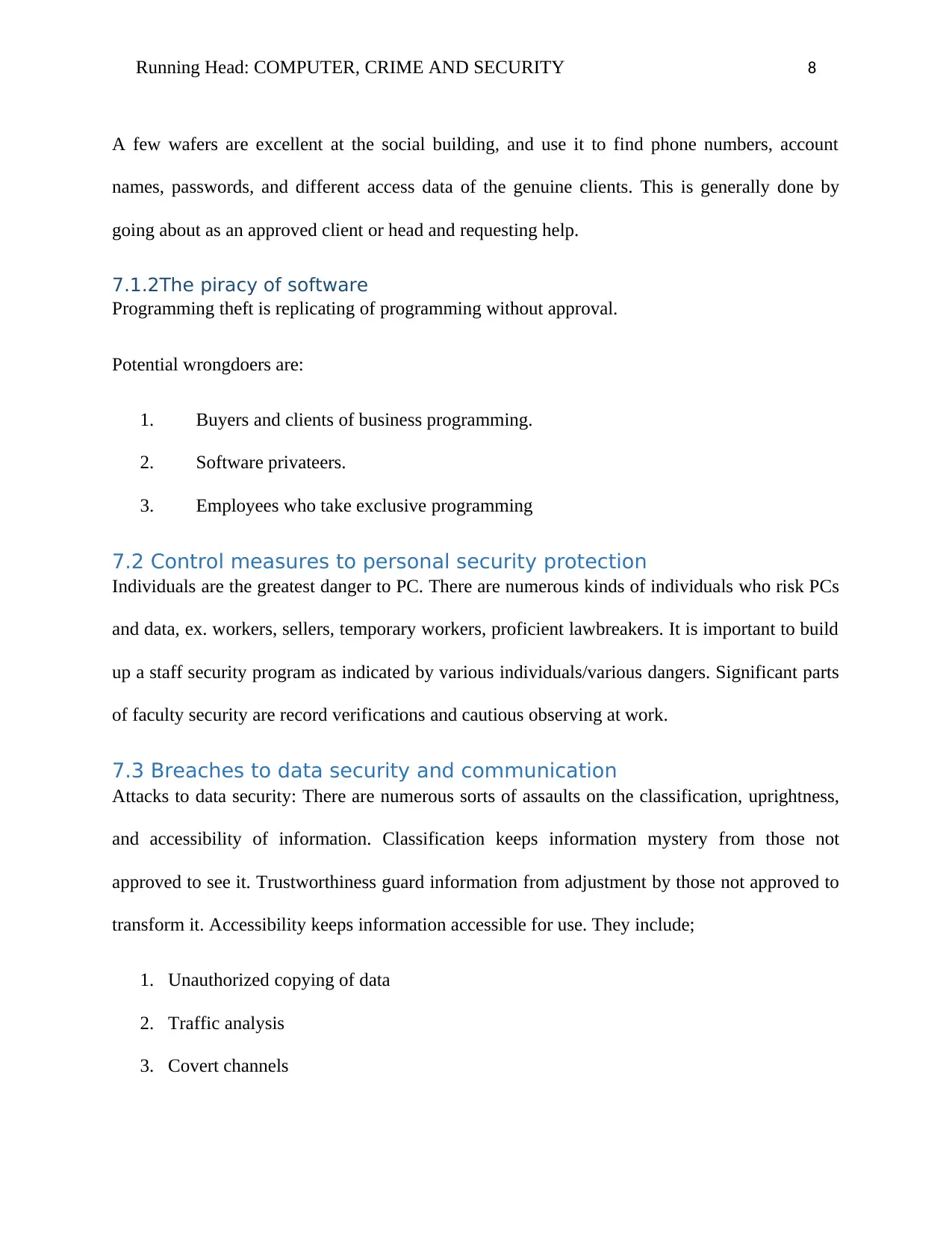
Running Head: COMPUTER, CRIME AND SECURITY 8
A few wafers are excellent at the social building, and use it to find phone numbers, account
names, passwords, and different access data of the genuine clients. This is generally done by
going about as an approved client or head and requesting help.
7.1.2The piracy of software
Programming theft is replicating of programming without approval.
Potential wrongdoers are:
1. Buyers and clients of business programming.
2. Software privateers.
3. Employees who take exclusive programming
7.2 Control measures to personal security protection
Individuals are the greatest danger to PC. There are numerous kinds of individuals who risk PCs
and data, ex. workers, sellers, temporary workers, proficient lawbreakers. It is important to build
up a staff security program as indicated by various individuals/various dangers. Significant parts
of faculty security are record verifications and cautious observing at work.
7.3 Breaches to data security and communication
Attacks to data security: There are numerous sorts of assaults on the classification, uprightness,
and accessibility of information. Classification keeps information mystery from those not
approved to see it. Trustworthiness guard information from adjustment by those not approved to
transform it. Accessibility keeps information accessible for use. They include;
1. Unauthorized copying of data
2. Traffic analysis
3. Covert channels
A few wafers are excellent at the social building, and use it to find phone numbers, account
names, passwords, and different access data of the genuine clients. This is generally done by
going about as an approved client or head and requesting help.
7.1.2The piracy of software
Programming theft is replicating of programming without approval.
Potential wrongdoers are:
1. Buyers and clients of business programming.
2. Software privateers.
3. Employees who take exclusive programming
7.2 Control measures to personal security protection
Individuals are the greatest danger to PC. There are numerous kinds of individuals who risk PCs
and data, ex. workers, sellers, temporary workers, proficient lawbreakers. It is important to build
up a staff security program as indicated by various individuals/various dangers. Significant parts
of faculty security are record verifications and cautious observing at work.
7.3 Breaches to data security and communication
Attacks to data security: There are numerous sorts of assaults on the classification, uprightness,
and accessibility of information. Classification keeps information mystery from those not
approved to see it. Trustworthiness guard information from adjustment by those not approved to
transform it. Accessibility keeps information accessible for use. They include;
1. Unauthorized copying of data
2. Traffic analysis
3. Covert channels
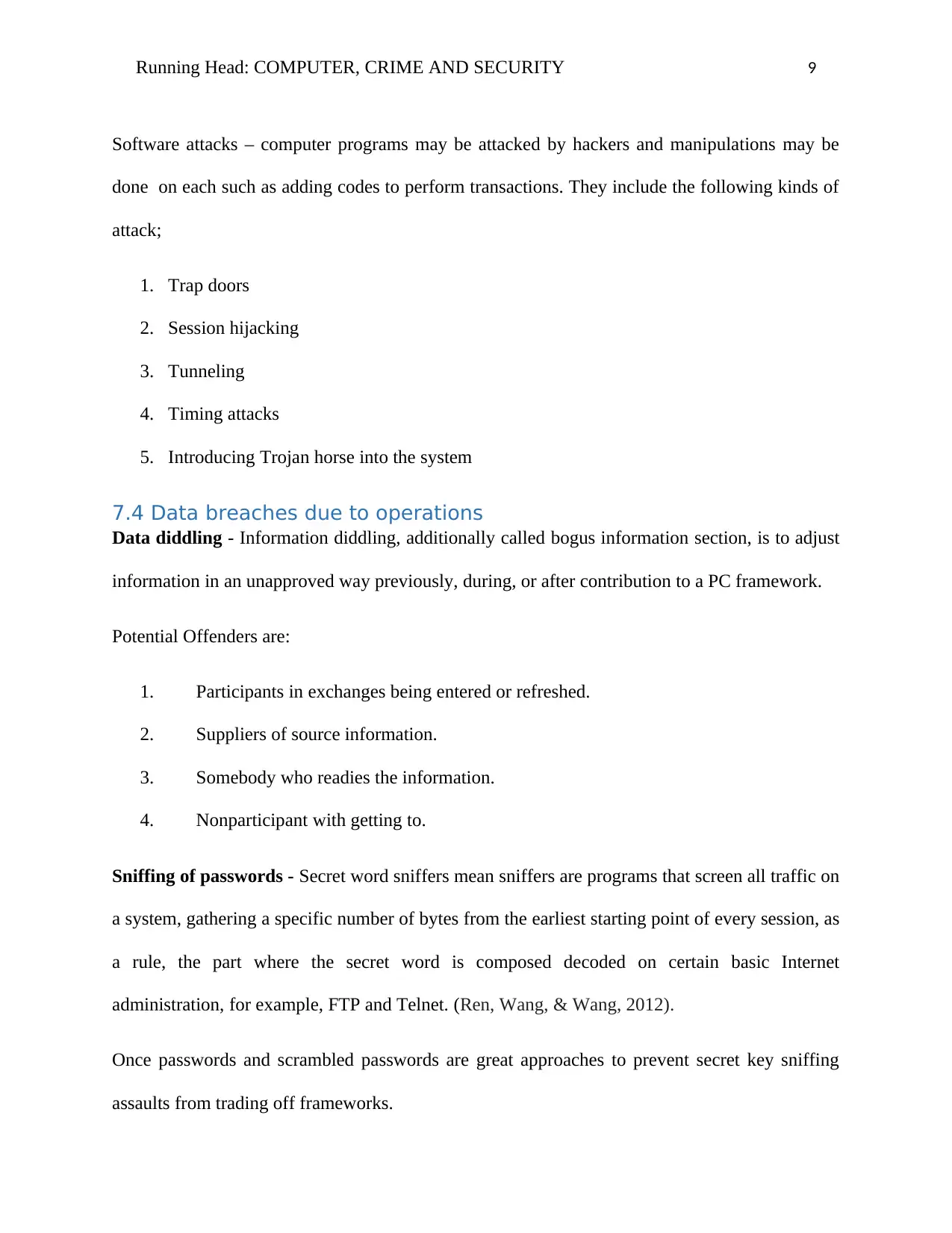
Running Head: COMPUTER, CRIME AND SECURITY 9
Software attacks – computer programs may be attacked by hackers and manipulations may be
done on each such as adding codes to perform transactions. They include the following kinds of
attack;
1. Trap doors
2. Session hijacking
3. Tunneling
4. Timing attacks
5. Introducing Trojan horse into the system
7.4 Data breaches due to operations
Data diddling - Information diddling, additionally called bogus information section, is to adjust
information in an unapproved way previously, during, or after contribution to a PC framework.
Potential Offenders are:
1. Participants in exchanges being entered or refreshed.
2. Suppliers of source information.
3. Somebody who readies the information.
4. Nonparticipant with getting to.
Sniffing of passwords - Secret word sniffers mean sniffers are programs that screen all traffic on
a system, gathering a specific number of bytes from the earliest starting point of every session, as
a rule, the part where the secret word is composed decoded on certain basic Internet
administration, for example, FTP and Telnet. (Ren, Wang, & Wang, 2012).
Once passwords and scrambled passwords are great approaches to prevent secret key sniffing
assaults from trading off frameworks.
Software attacks – computer programs may be attacked by hackers and manipulations may be
done on each such as adding codes to perform transactions. They include the following kinds of
attack;
1. Trap doors
2. Session hijacking
3. Tunneling
4. Timing attacks
5. Introducing Trojan horse into the system
7.4 Data breaches due to operations
Data diddling - Information diddling, additionally called bogus information section, is to adjust
information in an unapproved way previously, during, or after contribution to a PC framework.
Potential Offenders are:
1. Participants in exchanges being entered or refreshed.
2. Suppliers of source information.
3. Somebody who readies the information.
4. Nonparticipant with getting to.
Sniffing of passwords - Secret word sniffers mean sniffers are programs that screen all traffic on
a system, gathering a specific number of bytes from the earliest starting point of every session, as
a rule, the part where the secret word is composed decoded on certain basic Internet
administration, for example, FTP and Telnet. (Ren, Wang, & Wang, 2012).
Once passwords and scrambled passwords are great approaches to prevent secret key sniffing
assaults from trading off frameworks.
⊘ This is a preview!⊘
Do you want full access?
Subscribe today to unlock all pages.

Trusted by 1+ million students worldwide
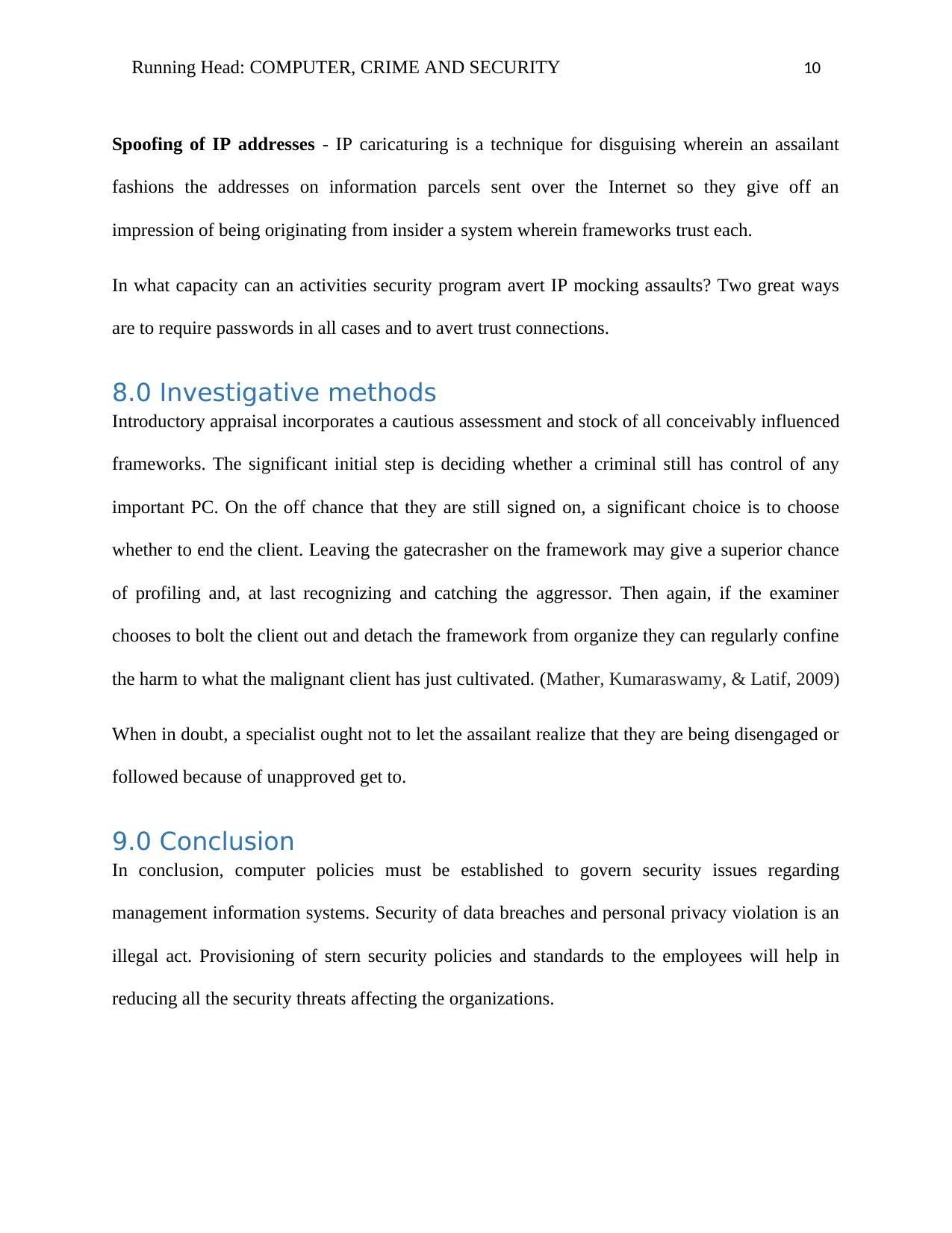
Running Head: COMPUTER, CRIME AND SECURITY 10
Spoofing of IP addresses - IP caricaturing is a technique for disguising wherein an assailant
fashions the addresses on information parcels sent over the Internet so they give off an
impression of being originating from insider a system wherein frameworks trust each.
In what capacity can an activities security program avert IP mocking assaults? Two great ways
are to require passwords in all cases and to avert trust connections.
8.0 Investigative methods
Introductory appraisal incorporates a cautious assessment and stock of all conceivably influenced
frameworks. The significant initial step is deciding whether a criminal still has control of any
important PC. On the off chance that they are still signed on, a significant choice is to choose
whether to end the client. Leaving the gatecrasher on the framework may give a superior chance
of profiling and, at last recognizing and catching the aggressor. Then again, if the examiner
chooses to bolt the client out and detach the framework from organize they can regularly confine
the harm to what the malignant client has just cultivated. (Mather, Kumaraswamy, & Latif, 2009)
When in doubt, a specialist ought not to let the assailant realize that they are being disengaged or
followed because of unapproved get to.
9.0 Conclusion
In conclusion, computer policies must be established to govern security issues regarding
management information systems. Security of data breaches and personal privacy violation is an
illegal act. Provisioning of stern security policies and standards to the employees will help in
reducing all the security threats affecting the organizations.
Spoofing of IP addresses - IP caricaturing is a technique for disguising wherein an assailant
fashions the addresses on information parcels sent over the Internet so they give off an
impression of being originating from insider a system wherein frameworks trust each.
In what capacity can an activities security program avert IP mocking assaults? Two great ways
are to require passwords in all cases and to avert trust connections.
8.0 Investigative methods
Introductory appraisal incorporates a cautious assessment and stock of all conceivably influenced
frameworks. The significant initial step is deciding whether a criminal still has control of any
important PC. On the off chance that they are still signed on, a significant choice is to choose
whether to end the client. Leaving the gatecrasher on the framework may give a superior chance
of profiling and, at last recognizing and catching the aggressor. Then again, if the examiner
chooses to bolt the client out and detach the framework from organize they can regularly confine
the harm to what the malignant client has just cultivated. (Mather, Kumaraswamy, & Latif, 2009)
When in doubt, a specialist ought not to let the assailant realize that they are being disengaged or
followed because of unapproved get to.
9.0 Conclusion
In conclusion, computer policies must be established to govern security issues regarding
management information systems. Security of data breaches and personal privacy violation is an
illegal act. Provisioning of stern security policies and standards to the employees will help in
reducing all the security threats affecting the organizations.
Paraphrase This Document
Need a fresh take? Get an instant paraphrase of this document with our AI Paraphraser
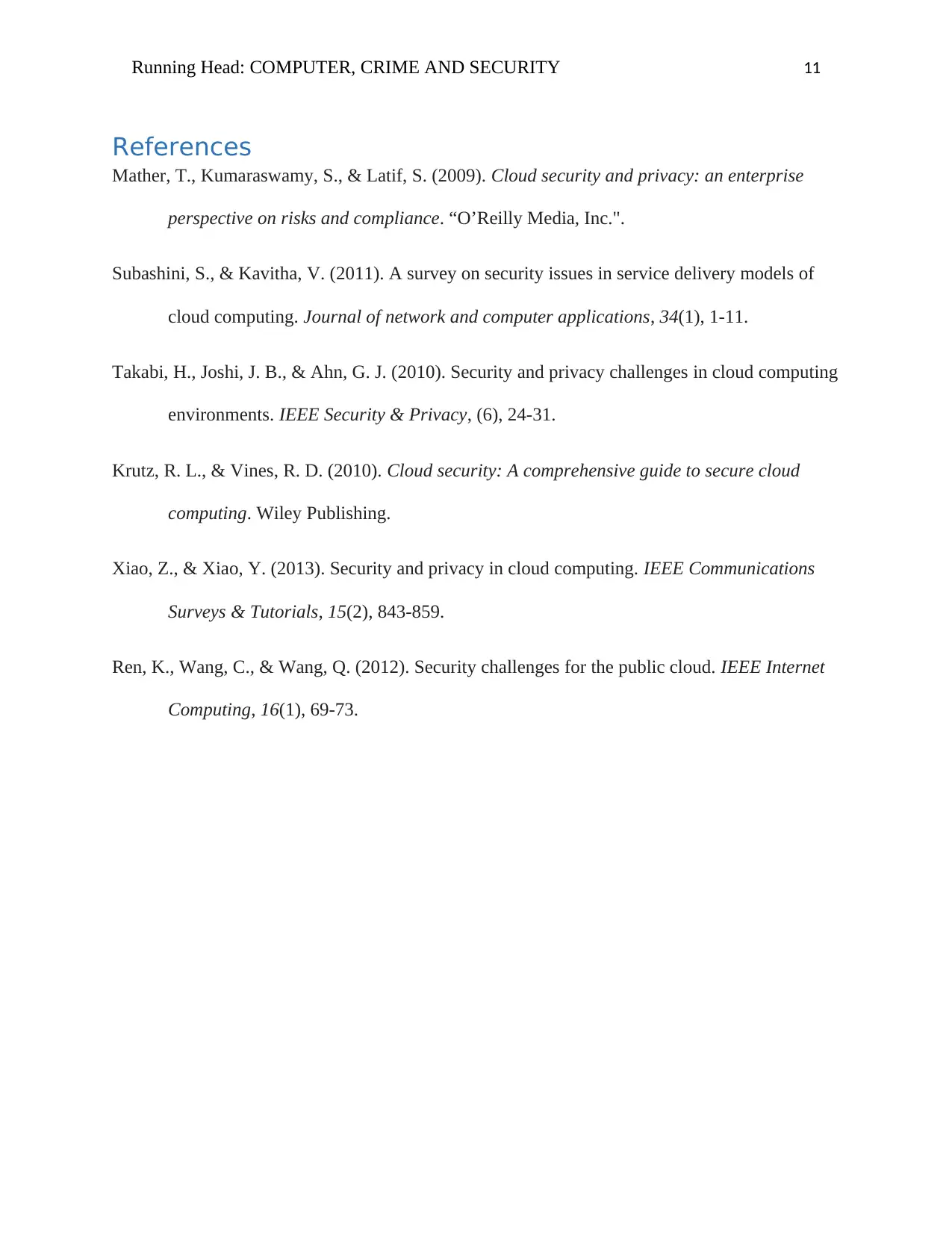
Running Head: COMPUTER, CRIME AND SECURITY 11
References
Mather, T., Kumaraswamy, S., & Latif, S. (2009). Cloud security and privacy: an enterprise
perspective on risks and compliance. “O’Reilly Media, Inc.".
Subashini, S., & Kavitha, V. (2011). A survey on security issues in service delivery models of
cloud computing. Journal of network and computer applications, 34(1), 1-11.
Takabi, H., Joshi, J. B., & Ahn, G. J. (2010). Security and privacy challenges in cloud computing
environments. IEEE Security & Privacy, (6), 24-31.
Krutz, R. L., & Vines, R. D. (2010). Cloud security: A comprehensive guide to secure cloud
computing. Wiley Publishing.
Xiao, Z., & Xiao, Y. (2013). Security and privacy in cloud computing. IEEE Communications
Surveys & Tutorials, 15(2), 843-859.
Ren, K., Wang, C., & Wang, Q. (2012). Security challenges for the public cloud. IEEE Internet
Computing, 16(1), 69-73.
References
Mather, T., Kumaraswamy, S., & Latif, S. (2009). Cloud security and privacy: an enterprise
perspective on risks and compliance. “O’Reilly Media, Inc.".
Subashini, S., & Kavitha, V. (2011). A survey on security issues in service delivery models of
cloud computing. Journal of network and computer applications, 34(1), 1-11.
Takabi, H., Joshi, J. B., & Ahn, G. J. (2010). Security and privacy challenges in cloud computing
environments. IEEE Security & Privacy, (6), 24-31.
Krutz, R. L., & Vines, R. D. (2010). Cloud security: A comprehensive guide to secure cloud
computing. Wiley Publishing.
Xiao, Z., & Xiao, Y. (2013). Security and privacy in cloud computing. IEEE Communications
Surveys & Tutorials, 15(2), 843-859.
Ren, K., Wang, C., & Wang, Q. (2012). Security challenges for the public cloud. IEEE Internet
Computing, 16(1), 69-73.
1 out of 11
Related Documents
Your All-in-One AI-Powered Toolkit for Academic Success.
+13062052269
info@desklib.com
Available 24*7 on WhatsApp / Email
![[object Object]](/_next/static/media/star-bottom.7253800d.svg)
Unlock your academic potential
Copyright © 2020–2025 A2Z Services. All Rights Reserved. Developed and managed by ZUCOL.




